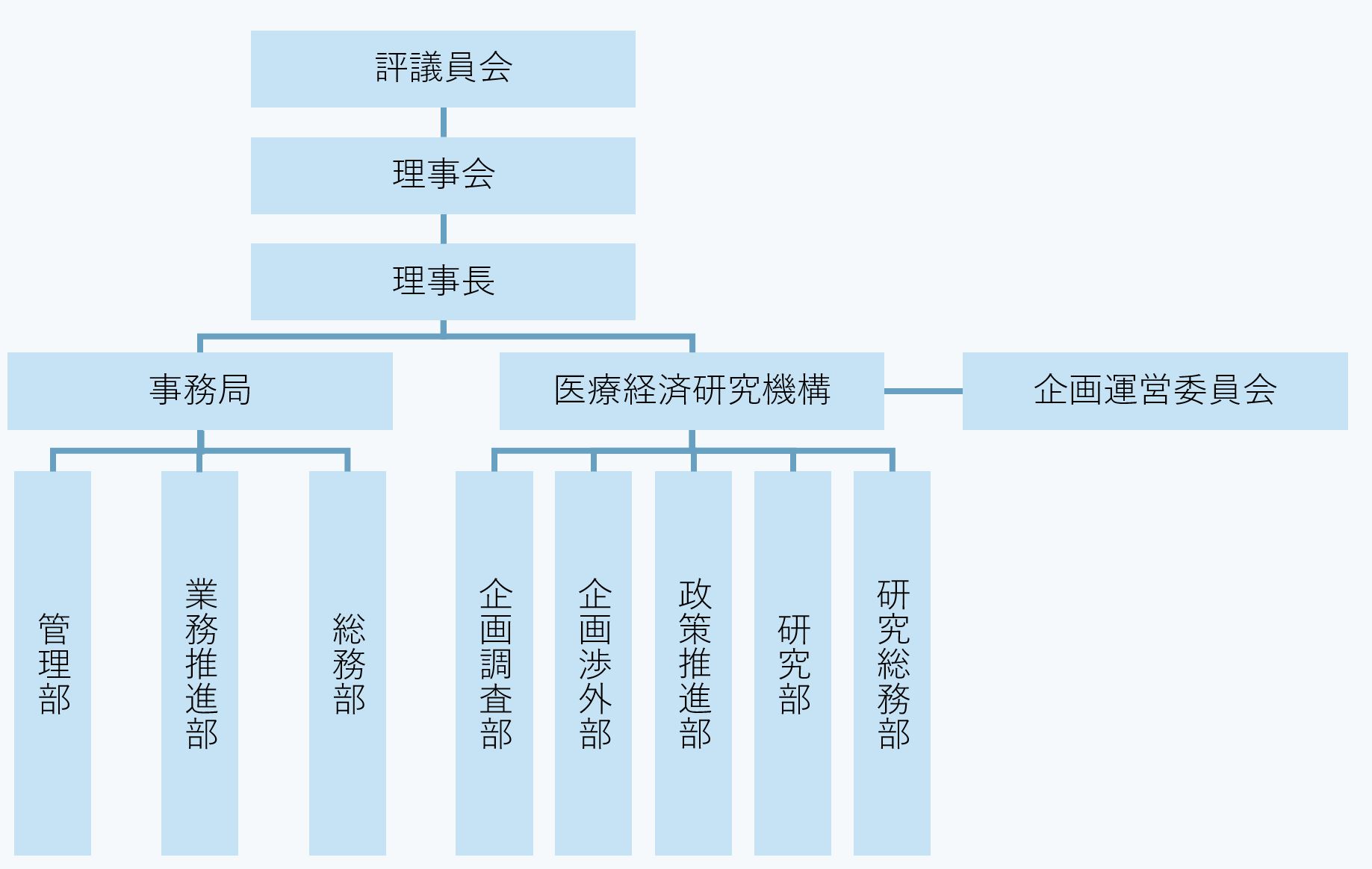IHEPについてABOUT US概要
幹部メッセージ
遠藤 久夫
医療経済研究機構
所長

当機構は、わが国における医療・介護政策の発展・向上に資するために、医療経済および医療・介護政策に関する研究を促進することを任務としております。
我が国は人生100年時代を迎え、今後更に高齢者世代の高齢化や人口減少が急速に進みます。従来の延長線上の発想から私達の頭を切り替えるとともに社会システムのイノベーションを進めていくことが求められています。このためには、関係者が結集して経済面を含めた総合的で実証的な政策研究を展開することが不可欠であると考えます。当機構はそのためのビックデータの解析を含めた政策研究のプラットホーム機能の一角を担えるよう努力してまいります。
皆様方の更なる御支援を賜りますようお願い申し上げます。

副所長印南 一路
広義の医療政策は、社会保障政策、科学技術政策、産業政策が交錯する複雑な領域です。政策の進展に寄与するためには、政治的中立性を保ちつつ、科学的エビデンスを収集し、タイミングよく世の中に出す必要があります。
医療経済学、政策疫学、医療情報学等関連する緒分野の知見を横断的に動員し、かつ政策形成過程も理解しなくてはなりません。
皆さまとの緊密な連携の下に、このような組織目的を実現したいと考えます。
組織概要
医療経済研究機構
医療経済研究機構は、わが国における医療経済および医療・介護政策に関する研究を促進することを目的とした研究機関です。医療・介護政策の発展・向上に資するために、経済学等の手法により、さまざまな事象を実証的に研究しています。
あわせて、医療経済等に関する情報の収集・蓄積、普及啓発、ならびにこの分野における専門的研究者の育成等も行っています。
1993年(平成5年)に厚生大臣認可の法人として設立され、1999年(平成11年)に「財団法人 社会保険福祉協会」と統合し、「財団法人 医療経済研究・社会保険福祉協会」となり、2011年(平成23年)4月、新公益法人制度の下で一般財団法人への移行認可を受け「一般財団法人 医療経済研究・社会保険福祉協会」となりました。
一般財団法人
医療経済研究・社会保険福祉協会
一般財団法人 医療経済研究・社会保険福祉協会は、社会保険制度の普及発展と社会保険被保険者等の福祉の増進を図ることを目的として、1964年(昭和39年)に設立された「財団法人 社会保険福祉協会」と、わが国の医療経済および社会保険制度に関する研究促進を目的として、1993年(平成5年)に設立された「財団法人 医療経済研究機構」が1999年(平成11年)に統合してできた法人です。
2011年(平成23年)4月、新公益法人制度の下で一般財団法人への移行認可を受け「一般財団法人 医療経済研究・社会保険福祉協会」となりました。
- 名称一般財団法人
医療経済研究・社会保険福祉協会
医療経済研究機構 - 所長遠藤 久夫
- 副所長印南 一路
- 設立1964年(昭和39年)12月28日 設立
2011年(平成23年)4月1日
一般財団法人へ移行 - 目的医療経済研究機構は、わが国における医療経済および医療・介護政策に関する研究を促進することを目的とした研究機関です。医療・介護政策の発展・向上に資するために、経済学等の手法により、さまざまな事象を実証的に研究しています。 あわせて、医療経済等に関する情報の収集・蓄積、普及啓発、ならびにこの分野における専門的研究者の育成等も行っています。
- 主な事業内容・医療経済及び医療・介護制度に関する調査研究事業
・医療経済に関するシンポジウムおよび各種研究会の開催等の普及啓発事業
・内外の医療経済等関連情報の収集・整理および研究者育成等の基盤整備事業 →上記3事業の詳細はこちら
(医療経済研究機構) ・健康食品フォーラムの開催、健康食品の安全性等に関する研究啓発事業
・訪問介護事業者、従事者等の人材育成および調査研究等
・年金被保険者住宅融資転貸貸付債権の管理回収等事業 →上記3事業の詳細はこちら
(一般財団法人 医療経済研究・社会保険福祉協会)
組織図
一般財団法人
医療経済研究・社会保険福祉協会

役員一覧令和4年7月1日現在
- 理事長辻󠄀 哲夫
- 常務理事
- 峯村 芳樹
- 清水 浩一
- 理事
- 遠藤 久夫学習院大学長
- 土田 武史早稲田大学 名誉教授
- 監事
- 小倉 征彦公認会計士
- 稻村 芳樹
- 企画運営委員
- 池上 直己慶應義塾大学 名誉教授
- 幸田 正孝医療経済研究・社会保険福祉協会 顧問
- 田中 滋埼玉県立大学 理事長
- 中村 洋慶應義塾大学 大学院経営管理研究科
教授/経営管理研究科委員長 - 野口 晴子早稲田大学 政治経済学術院 教授
- 橋本 英樹東京大学 大学院医学系研究科 教授
- 福田 敬国立保健医療科学院 保健医療経済評価研究センター長
アクセス
医療経済研究機構
〒105-0001 東京都港区虎ノ門1-21-19 東急虎ノ門ビル3F
一般財団法人 医療経済研究・社会保険福祉協会 医療経済研究機構
TEL: 03-3506-8529
FAX:03-3506-8528
IHEPについてABOUT USOVERVIEW
OVERVIEW
Institute for Health Economics and Policy
IHEP is a non-profit corporation approved by the Ministry of Health, Labor and Welfare. This research institute receives the full support of academic societies, the health care industry and the Japanese Government and was established to promote the studies of health economics and policy in Japan on October 1, 1993. The establishment of this kind of research institute had long been expected to activate the policy argument regarding Japanese health care issues, promote empirical studies in this field, and contribute to the development and improvement of health care policies. In response to the growing demand on health economics research, IHEP was founded with the strong support of specialists, researchers, medical institutions and the related industries.
The following are extracts from the IHEP prospectus
(This prospectus was drawn up as material for a promoters meeting held on May 14, 1993.)
The necessity to establish IHEP was explained as follows.
- 1
-
National medical expenses are currently estimated to exceed 24 trillion yen and to be more than 6% of national income.
Accordingly, the number of medical institutions is increasing year on year. There are more than 10 thousand hospitals, more than 80 thousand clinics and more than 50 thousand dental clinics. The number of people working at medical institutions amounts to more than 2 million.
There are a large variety of related industries in this field including the pharmaceutical industry, the medical equipment industry, the health care related distribution industry and the health care related service industry, and estimates of their output indicate the gradual strengthening of their positions in the Japanese industrial world.
Moreover, under the universal health insurance coverage system, the management of the health care insurance system has become an important financial administration problem which is now discussed in budget formation meetings every year.
- 2
-
Although health care occupies qualitatively and quantitatively important positions in the national economy, theoretical researches as to how to distribute economic resources for health care and empirical investigations fairly and efficiently and analyses of various economic/financial problems have not been thoroughly conducted. Some specialists have pointed out that health economics has not been established as a subject for scientific study in Japan.
- 3
-
In Europe and America, however, health economics has already been introduced into research education in universities. In these countries, there are many research institutes for highly academic health economic studies which contribute significantly to the improvement of the quality of health care services by conducting theoretical research, proposing policies and improving the quality of workers belonging to the health care industry.
The governments of European countries and America simultaneously establish and utilize these research institutes in various fields. In America, the development of diagnosis-related groups (DRGs) which are used as the basis for calculating hospital insurance benefits and the resource-based relative value scale (RBRVS) which is used as the basis for making the relative value scale, were the result of the studies conducted in the universities and private research institutes at the request of the Health Care Financing Administration.
- 4
-
In this environment, IHEP was established for the following purposes; to study the distribution of health care related resources and various economic and financial problems from the practical aspects of experience and policies, to educate specialists in health care economics, to found related research institutes and to train health care staff. Through these activities, the study of health economics in Japan can be promoted and reach a global level in the near future.
ORGANIZATION
Activities of departments
Research Department
Conducts research on important policy issues through transdisciplinary approaches.
Public Relations Department
Plans various projects such as academic symposia, meetings organized according to themes, research meetings and educational events and provides supporting members with important information.
Infrastructure Department
Strengthens the research infrastructure by establishing a health economics library, provides data and prepares data bases. Conducts government-sponsored studies.
General Affairs Department
Deals with general affairs (budgets, accounts, legal matters, etc).
Board of Executives
Director General: Hisao Endo
Deputy Director General: Ichiro Innami
Institute for Health Economics and Policy

ACCESS
Institute for Health Economics and Policy
3F Tokyu Toranomon Bldg.,1-21-19,Toranomon,Minato-ku,Tokyo,105-0001 Japan
Phone:+81 3-3506-8529 Facsimile:+81 3-3506-8528
